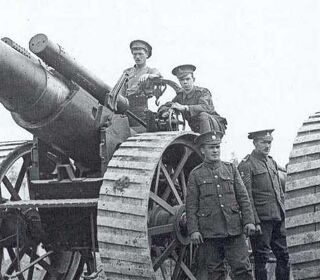
Blog

Technology has long played a part in the success and failure of military operations.
By Jonathan Jackson and Lily Hamourtziadou
From the advancement of the long bow in the Hundred Years' War to the use of drone strikes against the Islamic state group in 21st century Iraq, technology can dictate military strategy and steer nations into making decisions which are often extremely complicated. The key objective for technology is for it to reduce the commitment by states, by attempting to inflict maximum damage to the enemy, whilst minimising their own losses of men and material. However, technology can often lull commanders and politicians into a false sense of security, convincing both of these parties that conflicts can be won from a distance, without resulting to the deployment of large numbers of personnel.
Technology can however be undermined by the quality of its manufacturing, deployment in the field and whether the expectations set are simply outside of its capabilities. On more than one occasion, the huge political pressure to achieve results has seen the ignoring of technological shortcomings or overestimating its capabilities, with fatal consequences. This toxic mixture was no more clearly recognised than in July 1916, where the over reliance on technology and the misjudgment of capability would see the largest loss of life in one day that the British armed forces experienced before or since.
By 1916, the Great War had turned into a bloody stalemate with the European powers locked in a titanic struggle, fighting in a maze of trench systems which acted as a drain of men and supplies. Any opportunity to break this deadlock on the western front was exploited and in 1915 allied commanders had agreed that 1916 would be the year of the big offensive in the west. To achieve this, artillery technology would play a critical part in guaranteeing victory, but would lead to blurred understandings of its capability, blurring expectations.
A plan was perceived which would have at its heart a reliance on advancements in artillery to do the majority of the fighting by smashing a hole through the German lines. Such a gap would allow allied forces to flood out of the trenches and make fast advancements into northern France and Belgium. Originally, the battle plan would see the French army taking the lead but with the surprise German offensive at Verdun early in 1916, French divisions were diverted, leaving the British army to take the brunt of the battle. The Somme area was chosen, as it was in this area that the British and French armies met, making combined operations possible. Overall command of the offensive fell to Sir Douglas Haig and Sir Henry Rawlinson with the majority of fighting being done by the newly formed 'Pals Battalions', which comprised of local volunteers who had answered Lord Kitchener's call in 1914. Untested and lacking experience, the pals were enthusiastic but not battle hardened.
To counter this issue, both generals thought they could use technology to do the fighting for them. This was a clear example of trying to minimise their own casualties whilst continuing to take the fight to the enemy. The issue with warfare and over reliance on technology is often used to mask military failings, leading to huge exaggerations of its strategic capabilities in achieving victory.
With the Pals shortcomings in mind, artillery would play a central role in the upcoming offensive with the battle plan involving a seven day pre bombardment to smash the German trenches, leaving it free for the allied troops to simply walk over no man's land and occupy the enemy positions. However, artillery was in reality still in its infancy and what was being asked far outweighed the capabilities of the guns and shells at the time.
At the start of the war, artillery had often been mounted in the open, ensuring accuracy, but leaving it exposed to enemy fire. As a result of this, guns were now positioned away from the battlefield, meaning that they could not see the enemy targets when firing. This meant they relied on observation officers to rely locations back to them via field phones, which were unreliable and constantly at risk from enemy fire. This would have disastrous consequences at the Somme, as many guns were firing blind and not concentrating their firepower on specific locations. These failings were noted at the time, but in the euphoria of battle were routinely ignored.
Chosen as the weapon of choice for the bombardment would be the standard 18 pound shrapnel shell, designed to explode in the air and disperse tiny steel balls, cutting down men in the open. Hugely effective if used correctly, the lack of knowledge of the shell or its implementation meant that they would be used to destroy targets that they were not designed for.
The core objective for the artillery were the lines of barbed wire which protected the German trenches and the bunkers which housed the soldiers and stores. The shrapnel shell was simply not able to destroy these targets, as the balls bounced off the barbed wire, or failed to penetrate the deep bunkers. With political pressure in their home countries to break the deadlock, these problems were frequently ignored with commanders demanding more shells to be fired, in an attempt to overcome quality concerns with overwhelming quantity.
Regardless of the amount fired at the Somme, the design was not up to the task and most of the barbed wire remained undamaged. Once again the expectations of military technology were outweighed by its capabilities and in desperation many commanders turned the heads away, in order to believe that victory was possible.
To ensure a victory using a mass artillery bombardment would in turn require a great number of shells. However with many skilled workers away in their Pals battalions, ill- trained and under qualified factory workers were brought in to build the shells. This had an immediate effect on the quality of the final product produced with an estimated 30% of the 1.3 million shells fired at the Somme failing to explore. With a deadly combination of poor quality shells and high expectations, the artillery bombardment began and continued unchecked for seven days. It may have made a lot of noise, but in reality almost no strategic impact would be felt as the days passed.
As the smoke cleared and the guns fell silent on the morning of the 1st July 1916, young officers looked through their binoculars as the dust settled, aghast to see the wire uncut. Questioned but not retracted, soldiers were ordered to line up at the ladders and whistles were blown. Men walked slowly towards the lines giving time for enemy forces to reoccupy their defensive positions.
As the British and French soldiers approached the wire, their dreams quickly turned into nightmares. Stuck on the undamaged wire and nowhere to escape, casualties mounted. Rather than cancel further waves, reserves were thrown into the mix in a naive attempt to salvage the first day. Men would continue to be sacrificed at the altar of the myth that technology had not failed. The cruel reality was that, by sunset on the first day, the armies had experienced 57,450 casualties and over 19,000 were killed for almost no territorial gain.
The key to the horror of the Somme lay in the obsession placed on securing victory, which forced officers to accept myths rather than realities regarding the capabilities of the technology at their disposal. The operation had to work and this reluctance to accept flaws in the system would see such huge losses in a battle which would far from end the war. Contemporary commanders and politicians must remember that they have to focus on what military technology can achieve rather than what they want it to.
With modern commanders claiming that new innovations will reduce personnel on the ground may very well be reminded of the suffering of 1916 and how that dream lay buried with the soldiers in the mud. The advancement in military technology has allowed for killing to be far more distant, with drones even being flown unmanned all over the globe.
The use of drones in precision air strikes can be part of an effective military tactic. Unmanned aerial vehicles (UAV) or systems have several advantages compared to piloted aircraft, primarily the protection of life on the part of those who strike, but also on the ground, due to their ‘surgical precision’, sparing the lives of civilians. They are, it is claimed, accurate and efficient. As per International Law and the Geneva Conventions, all parties to a conflict must distinguish between combatants and non-combatants, the latter of whom are ‘protected persons’. The use of drones was meant to be both ethical and legal, respecting the law and protecting the vulnerable.
The alleged precision of drones and the implementing of this new technology would also cement the American myth of superiority and power in the war against terrorism.
The normalisation of targeted killing saw Obama’s use of drone warfare in Yemen, Somalia, Afghanistan, Pakistan, Iraq and Syria. Contrary to expectations, in Iraq alone over 4,000 civilians have been killed so far, according to Iraq Body Count. In some areas American drones killed as many Iraqi civilians as ISIS did. The aim has been to kill rather than capture.
On the road to victory, human security must not come second to national security. Any conception of ‘victory’ must include triumph over the sacrifice of innocent life.
Restructuring states requires a large scale commitment of resources and people, which is no myth. It is also important that commanders don't allow their expectations and dreams to cloud the strategic realities and capabilities of military technology.




